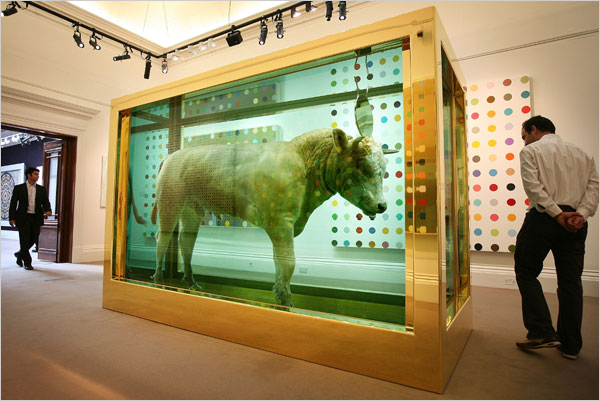MARKETWATCH
Marketwatch was created as a means to speculate on what is good economic value in art. From time to time I will write upon great market choices, emphasizing small-scale enterprises. When talking about art markets, comparisons to the stock market are inevitable, but are often not comparable at all. One need only look to the recent past when Damien Hirst’s works sold for an astonishing $200 million on the very same day the Dow dived 4% to make the Industrial average the lowest its been since 2001. So the day Lehman Brothers went bankrupt, Bank of America became the largest commercial bank ever by purchasing bankrupt lenders; Damien Hirst sells for hundreds of millions. Beyond showing the Dow’s incompatability, this proves beyond a doubt that art is a legitimate commodity and the producers of such forces are going to the top 1%. Art shows it is not so different from other corporate entities. One might say Damien Hirst is Bill Gates in that they each represent the top .1% of their respective markets. The amassing of such fortunes drives the capitalistic market and forces the majority of the money to the top individuals.
Of course, Damien Hirst is also a pioneer. Perhaps we should applaud Hirst for capitalizing, rather than say, Larry Gagosian. Hirst is, afterall, an inventor. While his recent output and sale might be what economists would call “brand maintenance”, (How else do you rationalize making so many of those spin paintings? And so many butterflies?), he did invent his brand. If the market says it can take 300 more spin paintings, why not make them?
So why not make them? This will be a re-occurring them of Marketwatch, one that speculates on what makes a good economy for art. For our case in point, Hirst would be wise to remember that the domination of any market is what creates homogeneity and boredom, ultimately leading to inferior product and less room for small-scale endeavors. Perhaps it is time we forget any notion of art being outside of the capitalist market, and focus on what makes an economically motivated piece of art successful. This does not mean production on a large scale, but production based on individual restraint and creative ingenuity. So why not make them? Well, because the majority of the public is sick of butterflies and want more nuanced output. And anyway, isn’t it easier to just forgo the hassle of hiring a large crew, creating ungodly amounts of overhead to make product that functions to keep the circulation of goods in narrow sectors? Why not take small lumps at a time?
Market domination also means buying back goodwill. Just like Bill Gates is “giving it all back”, look only to the near and foreseeable future when Hirst donates a gallery with his name. Or when he follows Charles Saatchi’s path and opens “The Hirst Gallery”. This space will cater to “emerging” artists at the start of their career, or those “forgotten” voices, exonerating Hirst for his greedy market domination, as well as pave the way for a new one.
The domination of markets puts power and influence in the hands of a few, making the history of art (or anything else) the story of long chapters dedicated to singular influences. This endless cycle of regrouping for the next wave of Capitalism is its fundamental fact, something Joseph Schumpeter called “Creative Destruction" (incidentally, Bill Gates has optioned for "creative capitalism" which calls for very successful businesses to "give back" to the needy). However, in the gaps of these cycles lay great economic creativity. The kinds based on simple principles of originality, ingenuity and a healthy awareness of niche markets with rationed sources. These great feats of economic poetry will be the focus of Marketwatch. In our reluctant acceptance of capitalism, we must be both consumer and producer, but it doesn’t mean that we have to expect or want the masses to take us in. Just a few will be fine, enough to make a living.
- Damien Hirst, The Golden Calf was the top seller at auction recently selling for 18.6 million.
Image via the New York Times and Peter Macdiarmid/Getty Images.





